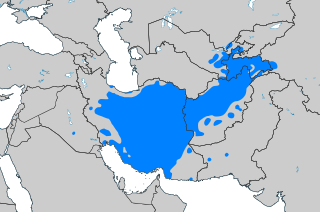| Standard Persian | |
|---|---|
| فارسی معیار | |
| Native to | |
Native speakers | 70 million[3] (110 million total speakers)[4] |
Standard forms | |
| |
| Official status | |
Official language in |
|
| Regulated by |
|
| Language codes | |
| ISO 639-1 | fa |
| ISO 639-2 | per (B) fas (T) |
| ISO 639-3 | fas |
| Glottolog | fars1254 |
| Linguasphere | 58-AAC (Wider Persian) > 58-AAC-c (Central Persian) |
 Areas with significant numbers of people whose first language is Persian (including dialects) | |
Standard Persian (Persian: فارسی معیار) is the standard variety of Persian that is the official language of Iran[5] and Tajikistan[6] and one of the two official languages of Afghanistan.[7] It is a set of spoken and written formal varieties used by the educated persophones of several nations around the world.[8]
As Persian is a pluricentric language, Standard Persian encompasses various linguistic norms (consisting of prescribed usage). Standard Persian practically has three standard varieties with official status in Iran, Afghanistan, and Tajikistan. The standard forms of the three are based on the Tehrani, Kabuli, and Bukharan varieties, respectively.[9][10]
- ^ a b c Samadi, Habibeh; Nick Perkins (2012). Martin Ball; David Crystal; Paul Fletcher (eds.). Assessing Grammar: The Languages of Lars. Multilingual Matters. p. 169. ISBN 978-1-84769-637-3.
- ^ "IRAQ". Encyclopædia Iranica. Retrieved 7 November 2014.
- ^ "Persian | Department of Asian Studies". Retrieved 2 January 2019.
There are numerous reasons to study Persian: for one thing, Persian is an important language of the Middle East and Central Asia, spoken by approximately 70 million native speakers and roughly 110 million people worldwide.
- ^ Windfuhr, Gernot (1987). Comrie, Berard (ed.). The World's Major Languages. Oxford: Oxford University Press. pp. 523–546. ISBN 978-0-19-506511-4.
- ^ a b Constitution of the Islamic Republic of Iran: Chapter II, Article 15: "The official language and script of Iran, the lingua franca of its people, is Persian. Official documents, correspondence, and texts, as well as text-books, must be in this language and script. However, the use of regional and tribal languages in the press and mass media, as well as for teaching of their literature in schools, is allowed in addition to Persian."
- ^ "Tajikistan Drops Russian As Official Language". RFE/RL – Rferl.org. 7 October 2009. Archived from the original on 4 March 2016. Retrieved 13 September 2013.
- ^ "What Languages are Spoken in Afghanistan?". 2004. Retrieved June 13, 2012.
Pashto and Dari are the official languages of the state. are – in addition to Pashto and Dari – the third official language in areas where the majority speaks them
- ^ "Standard Persian" (PDF). www.sid.ir. Retrieved 28 October 2020.
- ^ "History of Tehrani accent". Iranian students news agency. Retrieved 28 October 2020.
- ^ "Bukharan Tajik". www.cambridge.org. Retrieved 28 October 2020.